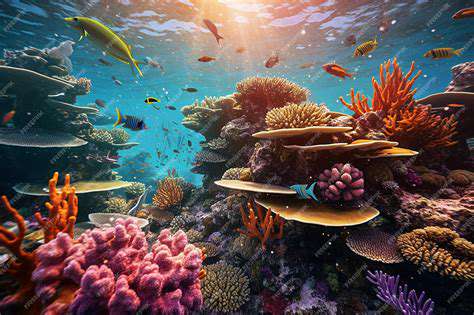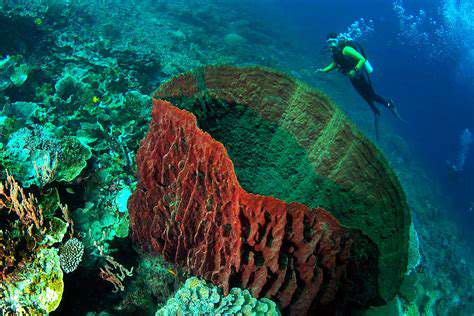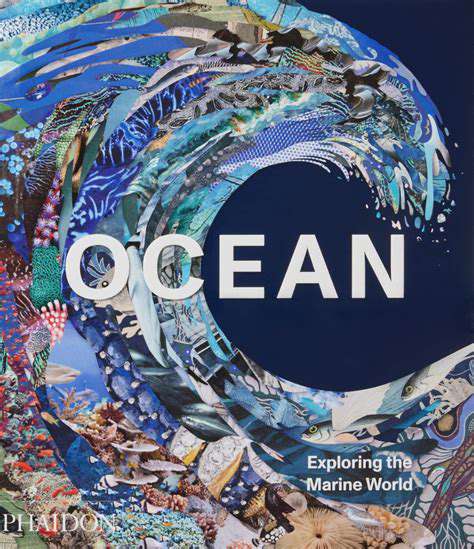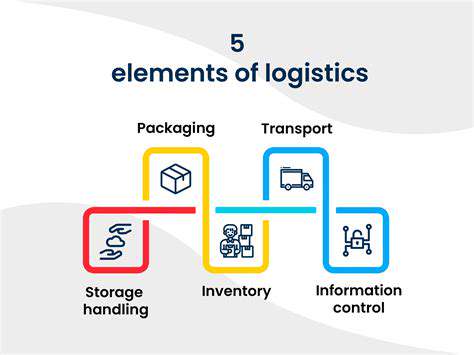Guide to Underwater Photography
Mastering Exposure and Composition Techniques Underwater
Understanding Light and Color Underwater
When diving into underwater photography, one quickly notices how light behaves differently beneath the surface. The deeper you go, the more colors fade, leaving mostly blues and greens. This color loss isn't just aesthetic - it fundamentally changes how we must approach photography underwater. Skilled photographers learn to work with these limitations, either by getting closer to subjects or using artificial lighting to bring back lost hues.
Different photography styles demand unique lighting approaches. For close-up shots of small creatures, strobes become essential to illuminate details that natural light can't reach. Mastering these lighting techniques separates casual snapshots from professional-grade underwater imagery.
Mastering Exposure Triangle Underwater
The basic photography principles of aperture, shutter speed, and ISO take on new meaning underwater. Water's density acts like a permanent filter, reducing light intensity at surprising rates. Underwater photographers often find themselves pushing their equipment to its limits - using wider apertures, higher ISOs, and faster shutter speeds than they would on land.
Successful exposure requires constant adjustment based on depth, water clarity, and available light. Many professionals recommend practicing with manual settings in shallow waters before attempting deeper dives. This hands-on experience helps develop the intuition needed for quick adjustments in changing conditions.
Exploring Composition Techniques for Impact
While traditional composition rules apply underwater, the environment adds unique challenges and opportunities. The three-dimensional nature of water allows for creative framing not possible on land. Skilled photographers use water's natural properties - like light refraction and particle suspension - to create ethereal, dreamlike effects. Currents and marine life movement can be incorporated into compositions to add dynamism.
Utilizing Equipment Effectively
Underwater photography demands specialized gear that can withstand harsh conditions while delivering quality results. Housing units must be meticulously maintained - a single leaking seal can destroy thousands of dollars in equipment. The choice between dome and flat ports significantly affects image quality, particularly for wide-angle shots where refraction matters most.
Lighting equipment requires particular attention underwater. Strobes need careful positioning to avoid backscatter from suspended particles, while continuous lights help with focus in dark conditions. Many professionals carry backup systems, as equipment failure during a dive can mean missing once-in-a-lifetime shots.
Post-Processing for Enhanced Visuals
Editing underwater photos requires specialized knowledge to correct the unique color casts and contrast issues caused by water. Advanced techniques like color channel mixing can recover lost hues that simple white balance adjustments miss. Many photographers develop custom presets for different depth ranges to streamline their workflow.
Beyond technical corrections, post-processing allows creative interpretation of underwater scenes. Careful dodging and burning can emphasize light beams, while localized contrast adjustments bring out texture in marine life. The goal is enhancing the image's natural beauty without creating an artificial look.
Tips for Capturing Stunning Marine Life

Planning Your Expedition
Successful marine photography begins long before entering the water. Researching locations involves more than finding pretty spots - understanding animal behavior patterns is crucial. Many marine creatures follow strict daily routines, appearing at specific sites only during certain tidal or light conditions. Local dive guides often possess invaluable knowledge about these patterns.
Preparation extends to physical conditioning, as strong currents or long dive times demand endurance. Photographers should also research local regulations, as many marine protected areas restrict certain activities. Respecting these rules preserves both the environment and future photographic opportunities.
Mastering Your Equipment
Underwater camera systems require different handling techniques than land-based gear. Buoyancy control becomes part of the photographic process - hovering motionless prevents stirring sediment that ruins shots. Many professionals practice equipment handling in swimming pools before ocean dives to build muscle memory.
Lens choices underwater often differ from terrestrial preferences. The water's magnification effect (about 25%) makes wide-angle lenses even wider, while macro lenses benefit from water's natural light diffusion. Specialized wet lenses that attach underwater provide flexibility without surfacing to change gear.
Understanding Light and Composition
Water transforms light in ways that challenge traditional photography knowledge. The surface acts as a constantly moving lens, creating dynamic light patterns that change by the second. Patient photographers wait for these magic moments when sunlight aligns perfectly with their subject.
Composition underwater must account for the viewer's inability to perceive distance accurately. Including familiar-sized objects helps establish scale, while careful framing prevents distracting backscatter from appearing as mysterious white dots. Many professionals shoot slightly upward to capture the surface's light while avoiding stirred-up bottom sediment.
Capturing Marine Life
Approaching marine life requires understanding animal behavior to avoid startling subjects. Slow, non-threatening movements often yield closer encounters than aggressive chasing. Some species become curious about cameras, while others require specialized techniques like night diving or baiting (where permitted).
Action shots demand anticipation, as water slows movement and shutter response times. Many professionals pre-focus on likely action spots and wait for the perfect moment. Burst modes help capture fast-moving subjects, though memory cards fill quickly with this approach.
Utilizing Post-Processing Techniques
Underwater images often require more aggressive editing than land photos to compensate for water's light-absorbing properties. Advanced techniques like luminosity masks allow targeted adjustments to different depth zones within a single image. Careful noise reduction becomes crucial when dealing with high-ISO underwater shots.
Color correction should aim for natural-looking results rather than artificial vibrancy. Many professionals keep reference shots of color charts at various depths to create accurate correction profiles. The goal is revealing the underwater world's true beauty, not creating a fantasy version.
Safety and Ethical Considerations
Underwater photographers carry extra responsibility as ambassadors for marine environments. One careless fin kick can destroy decades of coral growth, while improper behavior can stress marine animals. The best photographers leave no trace of their presence beyond their images.
Dive safety takes priority over getting the shot. Currents, depth, and air supply require constant monitoring, especially when concentrating on composition. Many professionals use redundant safety systems and always dive with a buddy, even when it complicates getting perfect shots.
Exploring Different Underwater Environments

Exploring the Coral Reef Ecosystem
Coral reefs represent underwater cities, bustling with life and intricate relationships. These ecosystems operate on delicate balances where each species plays a specific role. The vibrant colors we associate with reefs actually come from symbiotic algae living within the coral polyps. This mutually beneficial relationship forms the foundation of the entire reef ecosystem.
Photographing reefs requires understanding their fragile nature. Even slight contact can damage coral tissues that took years to grow. Many professionals use specialized floating techniques to maintain position without touching the bottom. Wide-angle lenses capture the reef's grandeur while macro lenses reveal its microscopic wonders.
The Importance of Maintaining Healthy Coral Reefs
Beyond their visual appeal, reefs provide measurable economic benefits through tourism, fisheries, and coastal protection. A single healthy reef can generate millions in annual tourism revenue while protecting shorelines from storm damage. Their intricate structures dissipate wave energy more effectively than human-made breakwaters.
Threats to Coral Reefs
Modern pressures on reefs extend beyond local issues to global challenges. Ocean acidification, caused by absorbed CO2, makes it harder for corals to build their skeletons. Even sunscreen chemicals have been shown to contribute to reef degradation, prompting many dive destinations to ban certain formulas. Photographers can document these changes to raise awareness.
The Role of Biodiversity in Reef Health
Diverse reef systems demonstrate remarkable resilience to environmental stresses. Areas with greater species variety tend to recover faster from bleaching events and other disturbances. This insurance effect comes from having multiple species that can fulfill similar ecological roles if some disappear.
Exploring the Deep Sea Environments
The deep ocean remains one of Earth's last frontiers, with new species discovered on nearly every expedition. Specialized equipment like remotely operated vehicles (ROVs) allows photographers to document these inaccessible realms. Bioluminescent organisms create their own light shows in perpetual darkness, offering unique photographic challenges.
Human Impact on Underwater Environments
Underwater photographers often become accidental witnesses to environmental damage. Ghost nets - abandoned fishing gear - continue trapping marine life indefinitely. Documenting these issues creates powerful visual evidence for conservation efforts. Many professionals participate in citizen science projects by recording species sightings and environmental conditions.
Sustainable Practices for Marine Conservation
The photography community has developed best practices to minimize environmental impact. These include maintaining neutral buoyancy, avoiding animal harassment, and participating in reef restoration projects. Many top underwater photographers now use their images to advocate for marine protected areas and sustainable fishing practices. Their work demonstrates that stunning imagery and environmental stewardship can go hand-in-hand.

![How to Travel on Points and Miles [Travel Hacking]](/static/images/27/2025-05/StayingUpdatedontheLatestTravelHackingTrendsandOpportunities.jpg)
![How to Pack a Carry On Only [Minimalist Guide]](/static/images/27/2025-05/AccessoriesandDocuments3AKeepingitCompactandOrganized.jpg)




![Tips for Flying with Kids [Stress Free Guide]](/static/images/27/2025-05/PlanningAheadforaSmoothFlight3APre-TripPreparation.jpg)



![Best Luxury Travel Credit Cards [2025]](/static/images/27/2025-05/ExploringSpecificCardOptionsfor2025.jpg)